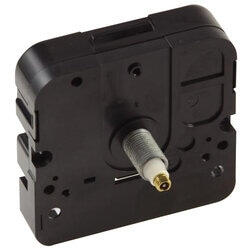Clock Motors

Making Best Use Of Performance of Clock MotorsClock electric motors control the timekeeping and other functional actions of watches. In today's globe, clock electric motors (or "movements" in the profession) are electronically powered, and a quartz crystal is the timing resource, vibrating at a high frequency and giving off a train of pulses, their count proportional for elapsed time. Therefore, we have a modern means of maintaining time, tantamount in look from the older mechanical clocks; nonetheless, the modern-day motion operates largely in software, permitting extra functions, some exotic and uncommon, to be implemented reasonably easily, especially when contrasted to their mechanical cousins.Conventional clock motors were mechanically created and developed, the only practical method. A coiled springtime or hanging weight provided prospective power, which in turn was exchanged kinetic energy by causing a flywheel to rotate. Pendulums and escapements regulated the regularity of rotation, causing a constant tick-tock at a properly fine-tuned rate of one second.However the mechanical structures had troublesome and bulky parts, which limited their abilities and made it challenging to adapt them to extended or cutting-edge styles. Hence, once it was uncovered that by subjecting a quartz crystal to a voltage drop triggers it to resonate and produce pulses at a specific rate, the tables were established for switching from a mechanical approach to a digital one for maintaining time. The availability of digital memory also assisted in the shift to an extra digital operation.Craftsmens of the past developed wrist watches that exhibited striking results, but the initiative was elaborate, painstaking, and involved innovative mechanical couplings to get the results to be in sync with temporal occasions. And, as such initiative became much less and much less cost-effective, it decreased eventually into a lost art. However, the contemporary programmable clock motor makes it simple to simulate these historic effects and even to accomplish greater ones.Naturally, electronic clocks (which are digital) present a different interface and extend the ordinary period (when everything resets) by tracking the moon phase, the weekday, and the complete day. Yet something is shed in this all-digital interface, and the motors we define here are basically analog (moving hands, conventional dial, etc), though with some solid-state circuitry. And yet they can reproduce the treasure wrist watches.The quartz crystal pulse-train is so exact that timing is near precise, and easy class brings the pace to the realm of secs and minutes. Moreover, it is straightforward to expand the length of the reset period by growing its trigger moment. Place additional info on the dial and include another hand to point at that info, and the days of the week or the days of the month are revealed along with common time.It is likewise as simple for the wrist watch to show the existing degree of the tide. This is additionally a periodic phenomenon, yet based on the lunar cycle of 1 day and 50 minutes. You can locate clock electric motors that execute this function, either as a standalone piece or integrated with typical timekeeping.Yet you can likewise get movements that track modifications in the weather (barometric pressure, humidity, or temperature level). These modifications are not regular, so the crystal is not the resource of the details presented; instead, sensing units take routine measurements, and their values are converted into a family member placement along a scale. The typical dial and hands are changed with a single hand that rotates backward and forward over the scale published in an arc along the area.There are still more features that we can discuss, such as continuous sweep pre-owneds, chimes, various cosmetic pendulums, and high-torque versions that let one build structures three feet across in size. Yet our room is consumed. The reader should currently have the essentials and the understanding for maximizing the functionality of clock motors.clock inserts